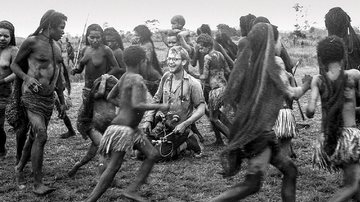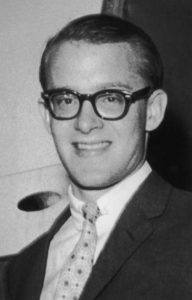The Vanishing Scion: Unraveling The Enduring Mystery Of Michael Rockefeller's Disappearance
The name Rockefeller conjures images of immense wealth, political power, and philanthropic endeavors that have shaped the modern world. Yet, within this illustrious lineage lies a story of profound mystery and enduring fascination – the disappearance of Michael Clark Rockefeller. More than six decades have passed since the young scion vanished off the remote coast of what was then Netherlands New Guinea, leaving behind a trail of unanswered questions and a legacy forever intertwined with the unknown. His story is not just a tale of an adventurous spirit, but a chilling reminder of the unforgiving nature of unexplored frontiers and the tantalizing allure of unresolved enigmas.
This article delves into the life, the fateful expedition, and the enduring mystery surrounding Michael Rockefeller's disappearance, exploring the known facts, the massive search efforts, and why his story continues to captivate the public imagination.
Who Was Michael Rockefeller? A Scion with a Different Calling
Born on May 18, 1938, Michael Clark Rockefeller was a member of one of America's most prominent families. He was the son of Nelson Rockefeller, a powerful political figure who would go on to serve as the Governor of New York and later as the U.S. Vice President under President Gerald Ford. Growing up amidst privilege and expectation, Michael could have easily followed a path in politics or business, yet his passions lay elsewhere.
Michael was a Harvard University graduate with a deep interest in anthropology and art, particularly the indigenous cultures of the world. He was drawn to the raw, untamed beauty of traditional societies and their artistic expressions. This fascination led him far from the polished boardrooms and political halls of New York, towards the distant and largely uncharted territories of New Guinea. His ambition was not to accumulate wealth or power, but to document and collect the unique art of the Asmat people, an indigenous group living in the remote southwestern part of the island. He understood the fleeting nature of these cultures in the face of modernization and felt a profound urgency to preserve their heritage.
The Ill-Fated Expedition: A Journey into the Unknown
In 1961, at the age of 23, Michael embarked on an expedition to Netherlands New Guinea (now Papua, Indonesia) with a Dutch anthropologist, René Wassing. Their mission was to collect Asmat artifacts for the Museum of Primitive Art, an institution founded by Michael's father in New York. This was not a casual trip; it was a serious anthropological endeavor, requiring resilience, courage, and a willingness to immerse oneself in a world vastly different from their own.
The region they explored was dense jungle, crisscrossed by rivers and swamps, home to communities that had little to no contact with the outside world. Travel was arduous, often relying on traditional canoes or small, unstable vessels. Michael was deeply committed to his work, meticulously documenting the art and customs of the Asmat people, acquiring pieces that would later become part of significant museum collections, including the Metropolitan Museum of Art.
- Chocolate Covered Strawberries San Francisco
- Brick Alien
- Fiorenna Stark
- Virginia Gold Cup Photos
- Alba Winter
The Day the World Lost a Rockefeller: November 19, 1961
The expedition was progressing, albeit with the inherent challenges of such remote travel, until November 18, 1961. Michael and René Wassing, along with two local guides, were navigating a wooden catamaran, a motorized outrigger canoe, on a journey between the coastal villages of Agats and Atsj in south New Guinea. The weather was calm, but the sea was unpredictable.
The Catamaran Incident: Stranded at Sea
Tragedy struck when their catamaran capsized. It's believed that the small vessel was overloaded, and a combination of strong currents and the shifting weight of its cargo caused it to overturn. They were left stranded in the open sea, approximately 12 miles from the shore. The two local guides bravely decided to swim for help, a perilous journey that they miraculously survived, eventually reaching shore and raising the alarm.
The Desperate Swim: A Decision Born of Hope and Desperation
Michael and Wassing clung to the overturned hull for a full night, battling exhaustion and the elements. By the morning of November 19, the situation had become dire. They were drifting further out to sea, and rescue seemed nowhere in sight. In a desperate bid to save himself and perhaps Wassing, Michael made a fateful decision. He fashioned two empty gasoline cans into makeshift flotation devices and, against Wassing's advice, announced, "I think I can make it." He then swam off towards the distant shore, leaving Wassing behind. This was the last confirmed sighting of Michael Clark Rockefeller.
Wassing was eventually rescued nearly 24 hours later by a Dutch naval patrol plane, clinging to the remains of the catamaran. But Michael was gone.
The Unanswered Questions and Enduring Mystery
The disappearance of a member of one of the world's most famous families immediately triggered a "gargantuan search effort" and ignited a "media firestorm" across the globe. Nelson Rockefeller himself flew to New Guinea to oversee the search, bringing with him vast resources and an army of search and rescue personnel. Planes, boats, and ground teams scoured the coastline, the rivers, and the dense jungle for weeks. Despite this unprecedented effort, Michael Clark Rockefeller was never found.
The Search and the Silence: No Trace, No Proof
The search was exhaustive, covering hundreds of square miles of treacherous terrain and water. Every possible scenario was considered, every lead pursued. Yet, no physical proof of Michael's fate was ever discovered. No body, no clothing, no definitive wreckage other than the capsized catamaran. The silence was deafening, fueling speculation and theories that continue to this day.
The Official Declaration and Lingering Theories
With no evidence to suggest otherwise, and after an extensive but fruitless search, the authorities eventually declared Michael Rockefeller dead due to drowning in 1964. This was the official conclusion, but for many, it felt like an unsatisfying end to a deeply unsettling mystery. The remoteness of the location, the presence of dangerous wildlife (like crocodiles), and historical accounts of tribal practices in the region led to other, more sensational theories.
While no physical proof has ever been found to confirm what happened to Michael, the lack of a body has kept alternative theories alive. Some speculate he drowned and was swept out to sea or became a victim of marine predators. Others, more controversially, suggest he might have reached shore only to encounter hostile indigenous tribes, specifically the Asmat people, some of whom were known to practice headhunting and ritualistic cannibalism at the time. However, these theories remain unproven and are often based on anecdotal evidence or sensationalized accounts rather than concrete facts.
One poignant observation from the provided data highlights a critical missing element: "If Michael Rockefeller had had a radio when his catamaran overturned in this exact spot in 1961, he never would have disappeared." This simple statement underscores the extreme isolation of his location and the primitive communication tools available at the time, which ultimately sealed his fate.
Michael Rockefeller's Legacy: An Enduring Name and a Haunting Story
Despite his tragic disappearance, Michael Clark Rockefeller's legacy lives on. His passion for art and anthropology, particularly his work with the Asmat people, had a lasting impact. The artifacts he collected, often under perilous circumstances, are now invaluable parts of major museum collections, offering a window into a culture that has since undergone significant change.
An Enduring Name in Art and Exploration
His name continues to be associated with significant cultural institutions. The story of Michael C. Rockefeller's mysterious 1961 disappearance makes news again whenever his contributions are highlighted, such as when the Metropolitan Museum of Art reopens a wing in his name. This connection ensures that while his personal fate remains unknown, his contributions to the world of art and anthropology are remembered and celebrated.
A Story That Haunts Generations
The story of Michael Rockefeller is more than just a historical footnote; it's a narrative that continues to haunt and intrigue. It embodies the allure of exploration, the fragility of life, and the enduring power of the unknown. His vanishing acts as a powerful metaphor for humanity's push into the last wild places on Earth, and the risks inherent in confronting nature's raw power. The mystery of what truly happened to him serves as a timeless reminder that even with immense resources and determination, some questions are destined to remain unanswered, forever lost in the mists of time and the depths of the jungle.
In conclusion, Michael Clark Rockefeller's disappearance in 1961 off the coast of New Guinea remains one of the most compelling and unsolved mysteries of the 20th century. The 23-year-old son of a prominent political figure, driven by a passion for anthropology and art, vanished after his catamaran capsized. Despite a gargantuan search effort and his official declaration of death by drowning in 1964, no physical proof of his fate has ever been found. His story continues to captivate, a poignant blend of adventure, tragedy, and an enduring enigma that underscores the untamed nature of the world and the limits of human knowledge.

Exploration Mysteries: The Disappearance of Michael Rockefeller

Michael Rockefeller: O misterioso sumiço de um dos homens mais ricos do

Michael Rockefeller: The Real Story Of How He Died